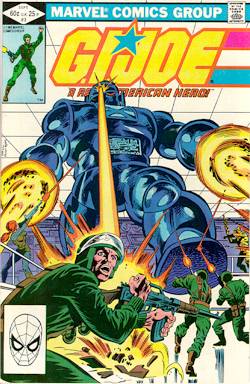
"Night Attack!"
Credits: Larry Hama (writer), Mike Vosburg (artist), Jon D'Agostino (inker), Joe Rosen (letterer), Andy Yanchus (colorist), Denny O'Neil (editor)
Feature Characters: Airborne (last seen in G.I. Joe #11, appears next in G.I. Joe #18), Breaker, Clutch, Cover Girl (Courtney S. Krieger, first appearance, full name revealed in G.I. Joe: Order of Battle #1), Doc, Flash (last seen in G.I. Joe #10), Grand Slam, Grunt, Gung Ho, Hawk, Rock 'N Roll, Scarlett, Short-Fuze, Stalker, Steeler, Torpedo (last seen in G.I. Joe #13), Tripwire (Tormod S. Skoog, first appearance, full name revealed in G.I. Joe Yearbook #1), Wild Bill, Zap
Clutch, Doc, Gung Ho, Rock 'N Roll, Wild Bill, and Zap were all last seen in G.I. Joe #14. Grand Slam, Short-Fuze, and Steeler were last seen in G.I. Joe #11
Supporting Characters: General Flagg (last seen in G.I. Joe #14, appears next in G.I. Joe #19)
Villains: Baroness, Cobra Commander, Cobra troops, Destro, Dr. Venom, Major Bludd, Scar-Face
Character Notes: Doc, Flash, Grand Slam, Grunt, Short-Fuze, and Stalker are strictly behind the scenes in this issue. Their presence in Washington, DC is revealed in the next issue.
Story: Cobra quietly invades Washington, DC in an attempt to poison the US money supply with Dr. Venom's biological toxin. When Cobra Commander implements his plan to assassinate Destro (using Major Bludd), the Baroness purposely crashes her tank to save him. Hawk faces off against Destro, leaving the Commander in a quandary of whom to kill.
Review: This was the very first issue read by young De. My friend Kevin and I read this issue aloud while sitting on the swing set outside his house. I think we might have made hang gliders for our action figures out of heavy bond paper earlier that afternoon. Anyway, enough reminiscing for now.
This is a fairly solid issue that advances the storyline at a fairly brisk pace. The training session that kicks off the story is pretty routine and does a decent job of introducing the new Wolverine missile tank and its driver, Cover Girl. While I had hoped there wouldn't be friction between Scarlett and Cover Girl, it's not outside of Scarlett's personality to bristle at outsiders. Tripwire introduction as a clumsy explosives expert is pretty hilarious if you think about it. Thankfully, this aspect is not played up for laughs too often.
My favorite scene in this issue is easily the dinner scene at Cobra headquarters when we get a glimpse into everyone's head to see how all of them are scheming in one way or another. The old adage of "no honor among thieves" is certainly in play here. Major Bludd is formally introduced to the rest of the Cobra cadre here; his true purpose as Destro's assassin a secret until later in the issue.
Hawk's meeting with General Flagg is rather telling. Cobra announces the Capitol building as their target, but Hawk is convinced that the Treasury is the actual target based on the clues found in Sierra Gordo and Vermont. However, Flagg is having none of it based on the incident in Vermont (where the G.I. Joe team blew up a furniture factory in broad daylight) and hoping to avoid a public panic. Speaking from personal experience, I live and work near DC and a panic would not only affect the city but a surrounding radius of about 25-30 miles. On September 11, 2001, getting out of the city and its immediate suburbs (such as Arlington, where the Pentagon is located) was a nightmare.
For the record, money is not printed at the Treasury Building, it's printed at the Bureau of Engraving and Printing. Yes, it's a division of the US Treasury but the buildings are located at a considerable distance from each other. The main building is near the White House while the Bureau is over near the tidal basin at the Jefferson Memorial. Oh, and the printing presses are underground and have been for a long time (I used to work there). You can't just walk inside and be greeted by printing equipment. All right, enough nitpicking.
The real barometer of the Destro-Baroness relationship comes when the Baroness sacrifices herself to save Destro from being killed by Major Bludd (manning the turret in her tank). Destro eventually composes himself to fist fight Hawk where the good colonel manages to land many a blow on Destro's steel mask. It's a bit silly but it's very minor in the face of the overall story. The Commander's decision to shoot Hawk is a pained one but it's a decision that allows Cobra to escape and fight another day.


















